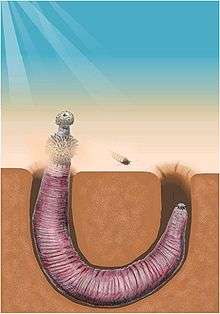Archaeopriapulida
| Archaeopriapulida | |
|---|---|
 | |
| Reconstruction of the celebrated archaeopriapulid Ottoia | |
| Scientific classification | |
| Kingdom: | Animalia |
| Stem group: | Priapulida (?) |
| Class: | †Archaeopriapulida |
| Species[1][2] | |
| |
Archaeopriapulida is a group of priapulid-like worms known from Cambrian lagerstätte.[16] The group is closely related to, and very similar to, the modern Priapulids.[17] It is unclear whether it is mono- or polyphyletic.[18] Despite a remarkable morphological similarity to their modern cousins,[19] they fall outside of the priapulid crown group, which is not unambiguously represented in the fossil record until the Carboniferous.[20] They are probably closely related or paraphyletic to the palaeoscolecids; the relationship between these basal worms is somewhat unresolved.[18]
References
- ↑ Smith, M. R.; Harvey, T. H. P.; Butterfield, N. J. (2015). "The macro- and microfossil record of the Cambrian priapulid Ottoia". Palaeontology. 58 (4): 705–721. doi:10.1111/pala.12168.
- ↑ Supplementary information from Smith, M.R.; Harvey, T.H.P.; Butterfield, N.J. (2015). "The macro- and microfossil record of the Cambrian priapulid Ottoia". Palaeontology. 58 (4): 705–721. doi:10.1111/pala.12168.
- ↑ Schmidt-Rhaesa, Andreas (2012-12-21). Nematomorpha, Priapulida, Kinorhyncha, Loricifera. ISBN 9783110272536.
- 1 2 3 4 5 Huang, D.-Y.; Vannier, J.; Chen, J.-Y. (2004). "Anatomy and lifestyles of Early Cambrian priapulid worms exemplified by Corynetis and Anningvermis from the Maotianshan Shale (SW China)". Lethaia. 37: 21–33. doi:10.1080/00241160410005088.
- 1 2 Ma, X.; Aldridge, R. J.; Siveter, D. J.; Siveter, D. J.; Hou, X.; Edgecombe, G. D. (2014). "A New Exceptionally Preserved Cambrian Priapulid from the Chengjiang Lagerstätte". Journal of Paleontology. 88 (2): 371. doi:10.1666/13-082.
- ↑ Hu, S.; Steiner, M.; Zhu, M.; Luo, H.; Forchielli, A.; Keupp, H.; Zhao, F.; Liu, Q. (2012). "A new priapulid assemblage from the early Cambrian Guanshan fossil Lagerstätte of SW China". Bulletin of Geosciences: 93–106. doi:10.3140/bull.geosci.1238.
- ↑ Hu, S.; Zhu, M.; Steiner, M.; Luo, H.; Zhao, F.; Liu, Q. (2010). "Biodiversity and taphonomy of the Early Cambrian Guanshan biota, eastern Yunnan". Science China Earth Sciences. 53 (12): 1765. doi:10.1007/s11430-010-4086-9.
- ↑ Han, J.; Zhang, X.; Zhang, Z.; Shu, D. (2006). "A new theca-bearing Early Cambrian worm from the Chengjiang Fossil Lagerstätte, China". Alcheringa: An Australasian Journal of Palaeontology. 30: 1–10. doi:10.1080/03115510608619340.
- ↑ Han, J.; Zhang, Z.; Liu, J.; Shu, D. (2007). "EVIDENCE OF PRIAPULID SCAVENGING FROM THE EARLY CAMBRIAN CHENGJIANG DEPOSITS, SOUTHERN CHINA". PALAIOS. 22 (6): 691–694. doi:10.2110/palo.2006.p06-117r. ISSN 0883-1351.
- ↑ Zeng, H.; Zhao, F.; Yin, Z.; Li, G.; Zhu, M. (2014). "A Chengjiang-type fossil assemblage from the Hongjingshao Formation (Cambrian Stage 3) at Chenggong, Kunming, Yunnan". Chinese Science Bulletin. 59 (25): 3169. doi:10.1007/s11434-014-0419-y.
- ↑ Huang, D.; Vannier, J.; Chen, J. (2004). "Recent Priapulidae and their Early Cambrian ancestors: Comparisons and evolutionary significance". Geobios. 37 (2): 217. doi:10.1016/j.geobios.2003.04.004.
- ↑ Han, J.; Shu, D.; Zhang, Z.; Liu, J. (2004). "The earliest-known ancestors of Recent Priapulomorpha from the Early Cambrian Chengjiang Lagerstätte". Chinese Science Bulletin. 49 (17): 1860. doi:10.1007/BF03183414.
- ↑ Liu, Y.; Xiao, S.; Shao, T.; Broce, J.; Zhang, H. (2014). "The oldest known priapulid-like scalidophoran animal and its implications for the early evolution of cycloneuralians and ecdysozoans". Evolution & Development. 16 (3): 155–65. doi:10.1111/ede.12076. PMID 24754444.
- ↑ Peel, John S; Willman, Sebastian (2018). "The Buen Formation (Cambrian Series 2) biota of North Greenland". Papers in Palaeontology. 4 (3): 381–432. doi:10.1002/spp2.1112.
- ↑ Peel, John S. (2017). "Feeding behaviour of a new worm (Priapulida) from the Sirius Passet Lagerstätte (Cambrian Series 2, Stage 3) of North Greenland (Laurentia)". Palaeontology. 60 (6): 795–805. doi:10.1111/pala.12316.
- ↑ Conway Morris, S. (1979). "The Burgess Shale (Middle Cambrian) Fauna". Annual Review of Ecology and Systematics. 10: 327–349. doi:10.1146/annurev.es.10.110179.001551.
- ↑ Por, F. D. (1983). "Class Seticoronaria and Phylogeny of the Phylum Priapulida". Zoologica Scripta. 12 (4): 267–272. doi:10.1111/j.1463-6409.1983.tb00510.x.
- 1 2 Wills, M. A. (1 April 1998). "Cambrian and Recent Disparity: the Picture from Priapulids". Paleobiology. 24 (2): 155–286. doi:10.2307/2401237 (inactive 2018-09-26). JSTOR 2401237.
- ↑ Huang, D.-Y.; Vannier, J.; Chen, J.-Y. (2004). "Anatomy and lifestyles of Early Cambrian priapulid worms exemplified by Corynetis and Anningvermis from the Maotianshan Shale (SW China)". Lethaia. 37: 21–33. doi:10.1080/00241160410005088.
- ↑ Budd, G. E.; Jensen, S. (2000). "A critical reappraisal of the fossil record of the bilaterian phyla". Biological Reviews of the Cambridge Philosophical Society. 75 (2): 253–95. doi:10.1111/j.1469-185X.1999.tb00046.x. PMID 10881389.
This article is issued from
Wikipedia.
The text is licensed under Creative Commons - Attribution - Sharealike.
Additional terms may apply for the media files.